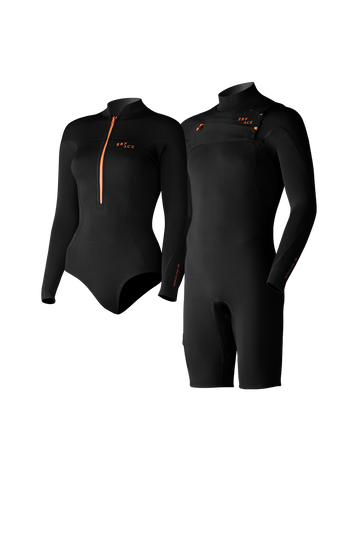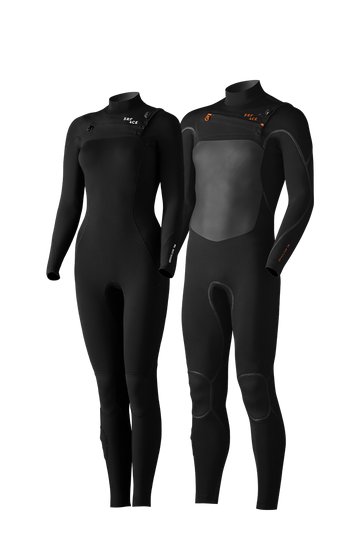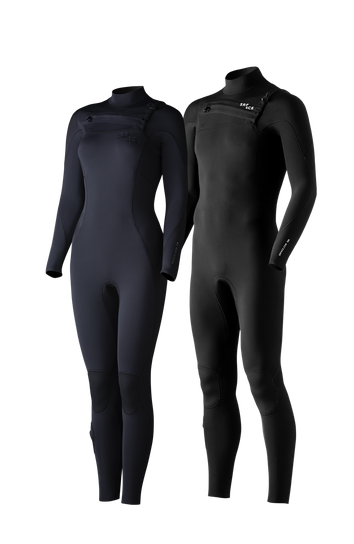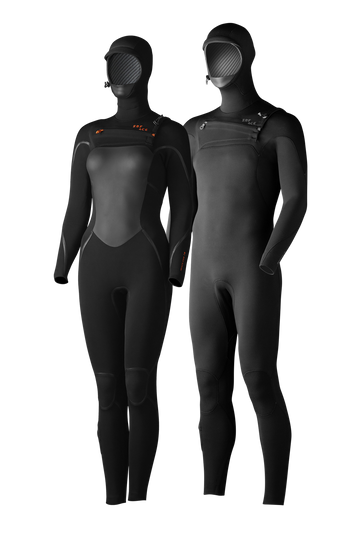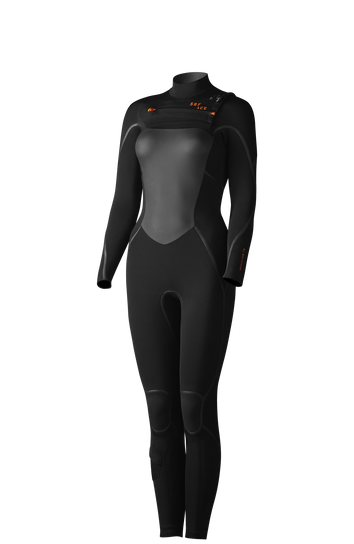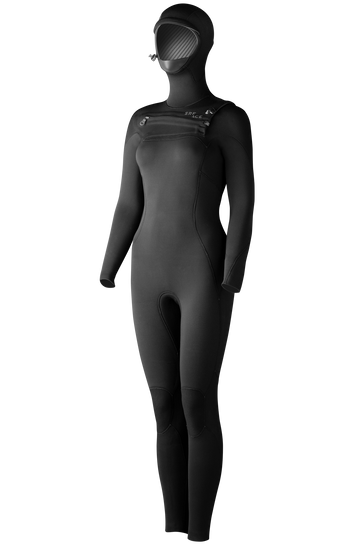
THICKNESS CALCULATOR
Find and shop the right wetsuit thickness!
| Wetsuit thickness | Temperature (℃) | Season | Shop Men | Shop Women |
|---|---|---|---|---|
| 2 / 2 | 18 - 35 ºC | Summer | Shop 2/2 now! | Shop 2/2 now! |
| 3 / 2 | 14 - 20 ºC | Summer | Shop 3/2 now! | Shop 3/2 now! |
| 4 / 3 | 10 - 18 ºC | Spring / Fall | Shop 4/3 now! | Shop 4/3 now! |
| 4 / 3 Hooded | 8 - 16 ºC | Spring / Fall | Shop 4/3 now! | Shop 4/3 now! |
| 5 / 4 | 5 - 13 ºC | Fall / Winter | Shop 5/4 now! | Shop 5/4 now! |
| 5 / 4 Hooded | 4 - 10 ºC | Winter | Shop 5/4 now! | Shop 5/4 now! |
| 6 / 5 Hooded | 2 - 8 ºC | Winter | Shop 6/5 now! | Shop 6/5 now! |
THE SCIENCE BEHIND WETSUIT THICKNESS
Picking the right wetsuit thickness can make a big difference in how warm and comfortable you stay in the water. Wetsuits, usually made from neoprene, keep you warm by trapping a thin layer of water between your skin and the suit. Your body heats that water, and the neoprene helps retain the warmth. The thicker the neoprene, the warmer you will be, so thicker wetsuits are better suited for colder water. Wetsuit thickness usually ranges from 2mm for hot summer days to 7mm for very cold conditions. The thickness you need depends on where you surf, the season, how easily you get cold, and how windy it is.
Tip: Be aware that next to shopping the right wetsuit thickness, also the right wetsuit size is really important. Check out our wetsuit size guide.
NEOPRENE THICKNESS EXPLAINED
Wetsuits are made from panels of neoprene that vary in thickness. You’ll often see numbers like 3/2, 4/3, or 6/5. These numbers indicate the neoprene thickness in millimetres. The first number refers to the thickness in the chest and back, where warmth is most important. The second number shows the thickness in more flexible areas, such as the arms and legs. For example, a 4/3 mm wetsuit means the torso is 4mm thick, while the arms and legs are 3mm.
Featured wetsuits
WETSUIT THICKNESSES: HOW DOES IT WORK?
Brands usually advertise their wetsuit neoprene thicknesses as 3/2, 4/3, 5/4, 6/5, etc. This indicates the different thicknesses in millimetres mostly used in the wetsuit. 3/2 for instance, means this wetsuit’s main panels are 3mm and 2mm thick. Normally, the chest and back panels are made out of thicker neoprene foam for extra warmth. Arms, shoulders, and legs are usually thinner for more flexibility. Thin summer wetsuits range between 1mm and 3mm. Spring or autumn wetsuits are normally made with 4mm and 3mm panels. You’ll find winter wetsuits in 5/4mm or 6/5mm.

HOW IS NEOPRENE THICKNESS MEASURED?
Neoprene thickness is usually measured before the inside and outside linings are added. This is why the overall thickness, including lining, is sometimes thicker than the neoprene thickness specified on the label. But watch out, some brands measure the thickness including the inside and outside lining. This means the actual neoprene foam can be thinner than expected, which might leave you feeling colder than you'd hoped. You can check the real thickness by looking at the arm or leg cuffs where the neoprene foam is exposed. If you are still not sure about the true thickness, there are special material thickness gauges available to check neoprene thickness.
THICK OR THIN? HOW TO DECIDE
Here’s the rule of thumb. If the water is cold, wear a thicker suit. If it’s warm, go thinner. If you’re someone who gets cold easily, it’s worth going a millimeter thicker. And if you're only out for short summer sessions or surf in warm places like Portugal in July, a thin wetsuit or even a rash vest might be all you need. If you are surfing in colder places where water temperature can drop below 10°C like the west coast of Ireland in December or January, you will definitely want a thick wetsuit with a hood.

WHICH THICKNESS WETSUIT FOR WHICH TEMPERATURE?
The location and season you are planning to use the wetsuit in, plays a huge role in choosing the right wetsuit neoprene thickness. Water and air temperatures at the time of the year are things to take into account. To give you an idea, below are our general recommendations of the best wetsuit neoprene thicknesses to use in different water temperatures.
2/2 MM WETSUIT: ABOVE 20°C
This is perfect for sunny days and warm water. A 2/2 mm wetsuit is light and stretchy with the same thickness distribution all over the suit. You will usually find these in short-sleeve or sleeveless designs. These wetsuits often use flatlock stitching which is not fully sealed, so water gets in, but that’s not a big deal when the ocean feels like a swimming pool.
3/2 MM WETSUIT: 15 TO 20°C
A 3/2 mm, also called a 3.2 or 3mm, is a standard summer wetsuit or springsuit thickness. It has 3mm neoprene in the core for warmth and 2mm in the arms and legs so you can paddle easily. The 3/2 thickness is great for early mornings or late summer when the air starts to cool down. It usually comes with better seams, for instance glued and blind stitched seams, to keep more water out.
4/3 MM WETSUIT: 12 TO 15°C
A 4/3 mm wetsuit, also called a 4.3 or 4mm, is the most common thickness for spring or autumn conditions. It features 4mm neoprene in the torso for warmth and 3mm in the arms and legs for flexibility. Most of these wetsuits have glued and blind stitched seams, plus a soft inside thermal lining to help trap body heat. The 4/3 mm wetsuit is a true all-rounder. In Europe, it can be used for the majority of the year, making it a favourite for surfers who want just one suit to cover most seasons. It is the go-to choice if you don’t surf during the coldest winter months.
5/3 MM WETSUIT: 9 TO 11°C
A 5/3 mm wetsuit, also called a 5.3 or 5mm, is a common winter wetsuit thickness. The thicker neoprene in the chest keeps you warm while the 3mm neoprene in the arms and legs allow you to move freely while surfing. Some 5/3 mm wetsuits use 4mm panels in spots like the sides to further improve your mobility when surfing. The seams are usually glued and blind stitched while some brands also apply an additional outside liquid seal. The 5/3 wetsuit always features an inside thermal lining for extra warmth. This thickness is generally used in late autumn or early spring when the water gets cold but not yet freezing.
Choose your wetsuit
5/4 MM WETSUIT: 8 TO 10°C
A 5/4 mm, also called a 5.4 or 5mm, is the most common thickness for a winter wetsuit. It is slightly warmer than a 5/3 mm due to the extra mm thickness in the arms. The same story applies here where 5mm panels are used on torso and upper legs, while the 4mm panels are used on the flex areas such as arms, shoulders and back lower legs. Some 5/4 mm wetsuits include in-between panel thicknesses, such as 4.5mm on the sides, though these are not always listed in the specs. The seams are always glued and blind stitched while some brands also apply an additional outside liquid seal. The 5/4 wetsuit always features an inside thermal lining for extra warmth. The 5/4 mm wetsuits are warm, durable, and offer a good mix of insulation and movement when surfing in cold winter waters.

5/4/3 MM WETSUIT: 8 TO 10°C
A 5/4/3 mm, also called a 5.4.3 or simply 5mm, is a slightly thicker winter wetsuit, similar to a 5/4 and 5/3 mm. Usually, the thicker 5mm panels are used in the chest and back for extra warmth. The 4mm panels are mainly used in the upper legs, while the 3mm panels are used in the more flexible areas such as arms, shoulders and lower legs. This thickness features the inside thermal lining and the glued and blind stitched seams, which may also be sealed on the outside. It is designed to provide warmth without sacrificing too much flexibility.
6/5 MM WETSUIT: BELOW 8°C
A 6/5 mm, also called a 6.5 or 6 mm, is a wetsuit designed for freezing cold winter waters. It has 6mm neoprene in the torso and 5mm in the arms and legs. Most of these wetsuits have a built-in hood and are fully sealed to keep the cold out. The seams are glued and blind stitched while also liquid sealed from the outside to not let any additional water in. The 6/5 mm thickness also always includes inside thermal lining. Thanks to new materials, these wetsuits are becoming warmer and more flexible than ever.
6/5/4 MM WETSUIT: BELOW 6°C
This suit is made for the coldest surf conditions. It uses 6mm in the chest, 5mm in the legs, and 4mm in the arms. These suits come with hoods, thermal linings, and seams that are liquid sealed from the outside. If you are the kind of surfer who does not stop when it snows, this is your kind of wetsuit.
6/5 MM WETSUIT: WATER TEMPERATURES BELOW 5°C
A 6/5 mm, also called a 6.5 or 6 mm, is an uncommon but extremely warm winter wetsuit. This wetsuit is mostly combined with a built-in hood. Panels range between 6mm and 5 mm. These suits are extremely warm.
When you understand wetsuit thickness and how it matches with water temperature, it is easier to pick a wetsuit that keeps you warm and lets you move. If you surf all year, it is a good idea to have a couple of different wetsuits for different seasons. A wetsuit that fits well and is the right thickness can really improve your surf sessions even in harsh conditions.

Ready to surf?
Shop from €159


